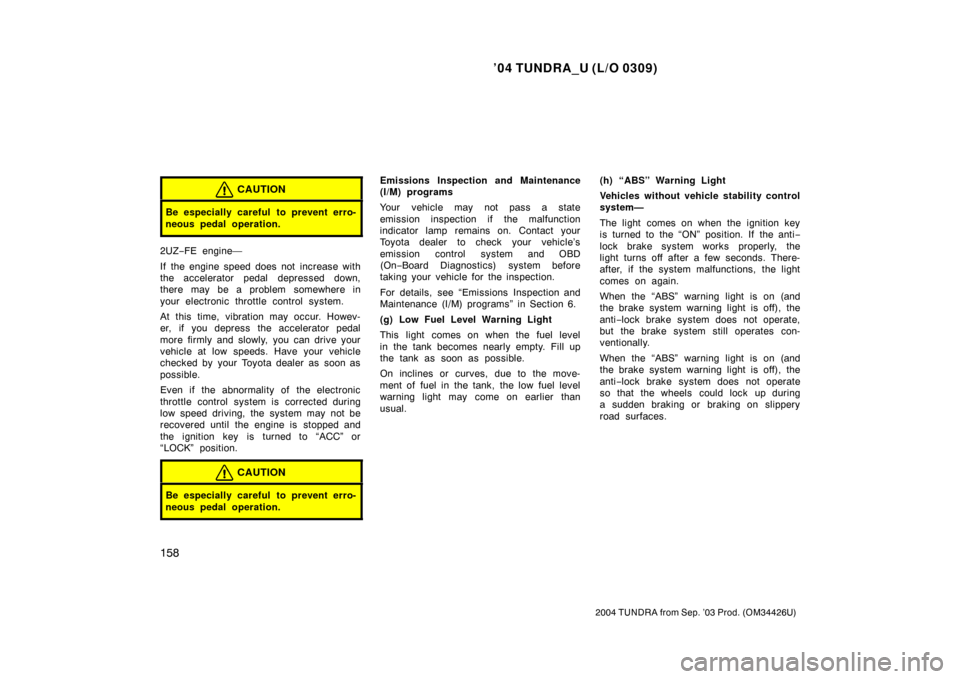2004 TOYOTA TUNDRA Emissions
[x] Cancel search: EmissionsPage 167 of 479

’04 TUNDRA_U (L/O 0309)
158
2004 TUNDRA from Sep. ’03 Prod. (OM34426U)
CAUTION
Be especially careful to prevent erro-
neous pedal operation.
2UZ−FE engine—
If the engine speed does not increase with
the accelerator pedal depressed down,
there may be a problem somewhere in
your electronic throttle control system.
At this time, vibration may occur. Howev-
er, if you depress the accelerator pedal
more firmly and slowly, you can drive your
vehicle at low speeds. Have your vehicle
checked by your Toyota dealer as soon as
possible.
Even if the abnormality of the electronic
throttle control system is corrected during
low speed driving, the system may not be
recovered until the engine is stopped and
the ignition key is turned to “ACC” or
“LOCK” position.
CAUTION
Be especially careful to prevent erro-
neous pedal operation.
Emissions Inspection and Maintenance
(I/M) programs
Your vehicle may not pass a state
emission inspection if the malfunction
indicator lamp remains on. Contact your
Toyota dealer to check your vehicle’s
emission control system and OBD
(On −Board Diagnostics) system before
taking your vehicle for the inspection.
For details, see “Emissions Inspection and
Maintenance (I/M) programs” in Section 6.
(g) Low Fuel Level Warning Light
This light comes on when the fuel level
in the tank becomes nearly empty. Fill up
the tank as soon as possible.
On inclines or curves, due to the move-
ment of fuel in the tank, the low fuel level
warning light may come on earlier than
usual. (h) “ABS” Warning Light
Vehicles without vehicle stability control
system—
The light comes on when the ignition key
is turned to the “ON” position. If the anti
−
lock brake system works properly, the
light turns off after a few seconds. There-
after, if the system malfunctions, the light
comes on again.
When the “ABS” warning light is on (and
the brake system warning light is off), the
anti −lock brake system does not operate,
but the brake system still operates con-
ventionally.
When the “ABS” warning light is on (and
the brake system warning light is off), the
anti −lock brake system does not operate
so that the wheels could lock up during
a sudden braking or braking on slippery
road surfaces.
Page 329 of 479

’04 TUNDRA_U (L/O 0309)
320
2004 TUNDRA from Sep. ’03 Prod. (OM34426U)
OCTANE RATING
Select Octane Rating 87 (Research Oc-
tane Number 91) or higher.
Use of unleaded gasoline with an octane
rating or research octane number lower
than stated above will cause persistent
heavy knocking. If it is severe, this will
lead to engine damage.
If your engine knocks...
If you detect heavy knocking even when
using the recommended fuel, or if you
hear steady knocking while holding a
steady speed on level roads, consult your
Toyota dealer.
However, occasionally, you may notice
light knocking for a short time while accel-
erating or driving up hills. This is normal
and there is no need for concern.
GASOLINE CONTAINING DETERGENT
ADDITIVES
Toyota recommends the use of gasoline
that contains detergent additives to
avoid build�up of engine deposits.
However, all gasoline sold in the U.S.
contains detergent additives to keep clean
and/or clean intake systems. QUALITY GASOLINE
Automotive manufacturers in the U.S.,
Europe and Japan have developed a
specification for quality fuel named
World�Wide Fuel Charter (WWFC) that
is expected to be applied world wide.
The WWFC consists of four categories
that depend on required emission lev-
els. In the U.S., category 3 has been
adopted. The WWFC improves air quali-
ty by providing for better emissions in
vehicle fleets, and customer satisfaction
through better vehicle performance.
CLEANER BURNING GASOLINE
Cleaner burning gasoline, including re-
formulated gasoline that contains oxy-
genates such as ethanol or MTBE is
available in many areas.
Toyota recommends the use of cleaner
burning gasoline and appropriately blended
reformulated gasoline. These types of gas-
oline provide excellent vehicle perfor-
mance, reduce vehicle emissions, and im-
prove air quality.
OXYGENATES IN GASOLINE
Toyota allows the use of oxygenate
blended gasoline where the oxygenate
content is up to 10% ethanol or 15%
MTBE. If you use gasohol in your
Toyota, be sure that it has an octane
rating no lower than 87.
Toyota does not recommend the use of
gasoline containing methanol.
GASOLINE CONTAINING MMT
Some gasoline contain an octane en-
hancing additive called MMT (Methylcy-
clopentadienyl Manganese Tricarbonyl).
Toyota does not recommend the use of
gasoline that contains MMT. If fuel con-
taining MMT is used, your emission con-
trol system may be adversely affected.
The Malfunction Indicator Lamp on the in-
strument cluster may come on. If this hap-
pens, contact your Toyota dealer for ser-
vice.
GASOLINE QUALITY
In a very few cases, you may experience
driveability problems caused by the partic-
ular gasoline that you are using. If you
continue to have unacceptable driveability,
try changing gasoline brands. If this does
not rectify your problem, then consult your
Toyota dealer.
Page 408 of 479

’04 TUNDRA_U (L/O 0309)
399
2004 TUNDRA from Sep. ’03 Prod. (OM34426U)
VEHICLE MAINTENANCE AND CARE
Vehicle maintenance and care
Maintenance requirements 400
. . . . . . . . . . . . . . . . . . . . . . . . . . . . . . . . . .
General maintenance 401
. . . . . . . . . . . . . . . . . . . . . . . . . . . . . . . . . . . . \
. . .
Does your vehicle need repairing? 403
. . . . . . . . . . . . . . . . . . . . . . . . . . . .
Emissions Inspection and Maintenance (I/M) programs 404
. . . . . . . . .
For scheduled maintenance information, please refer to the “Scheduled Mainte-
nance Guide” or “Owner’s Manual Supplement”.
SECTION 6
Page 413 of 479

’04 TUNDRA_U (L/O 0309)
404
2004 TUNDRA from Sep. ’03 Prod. (OM34426U)
Some states have vehicle emission in-
spection programs which include OBD
(On−Board Diagnostics) che cks.
The OBD system monitors the operation
of the emission control system. When the
OBD system determines that a problem
exists somewhere in the emission control
system, the malfunction indicator lamp
comes on. In this case, your vehicle may
not pass the I/M test and need to be
repaired. Contact your Toyota dealer to
service the vehicle.
Even if the malfunction indicator lamp
does not come on, your vehicle may not
pass the I/M test as readiness codes
have not been set in the OBD system.
Readiness codes are automatically set
during ordinary driving. However, when the
battery is disconnected or run down, the
codes are erased. Also, depending on
your driving habits, the codes may not be
completely set. Also, if the malfunction indicator lamp had
come on recently due to temporary mal-
function such as a loose fuel tank cap,
your vehicle may not pass the I/M test.
The malfunction indicator lamp will go off
after taking several driving trips, but the
error code in the OBD system will not be
cleared unless about 40 trips or more are
taken.
If your vehicle does not pass the I/M test
even the malfunction indicator lamp does
not come on, contact your Toyota dealer
to prepare the vehicle for re
−testing.
Emissions Inspection and
Maintenance (I/M) programs